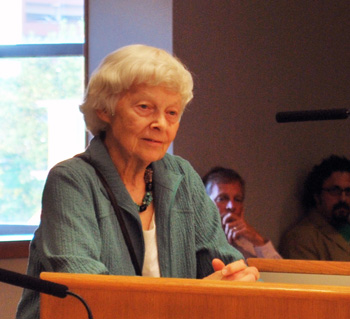At its Aug. 15, 2011 meeting, the Ann Arbor city council approved the temporary loan of $3 million from its pooled investment fund (Fund 0099) to the building fund for its new municipal center (Fund 0008), which is nearing completion.
The loan is needed because the sale of the city-owned First and Washington property to Village Green for its City Apartments development has not yet been finalized. The new municipal center’s financing plan included $3 million in proceeds from that sale. The loan from the city’s pooled investment funds will allow the construction bills to be paid.
The city’s pooled investment fund includes all eligible cash across all city funds – interest earned on the pooled funds is apportioned back to each fund based on the relative amount of cash from that fund in the pool.
The building fund will incur a cost of 1.93% annual interest on the money lent from the investment pool. According to the staff memo accompanying the resolution, on a short-term basis, the interfund lending approach is more desirable than borrowing money from a lending institution, because of lower transaction costs, lower interest rates and no prepayment penalties. The short-term financing strategy of lending the building fund $3 million from the pooled investment fund will not have an impact on the city’s general fund, if the land sale is finalized. However, the short-term financing strategy does not eliminate the risk to the general fund, if the land sale does not go through.
The city bonded for about $47 million for the municipal building project. The yearly bond payments of $1.85 million can be broken down roughly as follows: $508,000 in TIF capture pledged by the Ann Arbor Downtown Development Authority; $490,000 in revenue from antenna rights; $455,000 in elimination of leases for space; $175,000 in elimination of utilities for leased space; $225,000 pledged by the 15th District Court facility fund.
The council had been advised by interim city administrator and chief financial officer Tom Crawford at its Aug. 4, 2011 meeting to expect some kind of short-term financing proposal on its Aug. 15 agenda. And more than a year earlier, at a city council work session in April 2010, the council discussed the city’s contingency plan of taking out short-term financing in the event the land sale did not materialize.
With respect to the land sale, at its Aug. 4 meeting, the council extended the purchase option agreement with the developer Village Green for the city-owned First and Washington site, where the developer plans to build Ann Arbor City Apartments. It’s a 9-story, 99-foot-tall building with 156 dwelling units, which includes a 244-space parking deck on its first two stories.
The land deal was originally set at $3.3 million, but was reduced by the council at its June 6, 2011 meeting to $3.2 million. The reduction in price approved at the council’s June 6 meeting was based on a “bathtub design” for the foundation that is intended to prevent water from ever entering the parking structure, eliminating the need for pumping water out into the city’s stormwater system. However, the Aug. 4 purchase option extension came at a cost of $50,000 to Village Green.
The parking deck portion of Village Green’s City Apartments project is being developed in cooperation with the Ann Arbor Downtown Development Authority, which has pledged to make payments on around $9 million worth of bonds, after the structure is completed and has been issued a permit for occupancy.
According to the staff memo accompanying the Aug. 4 resolution, Village Green still hopes to break ground on the project in the 2011 construction season.
As a historical point related to the planned use of the sale proceeds for the new municipal center construction, the council defeated a resolution on March 17, 2008 to extend the Village Green purchase option agreement for First and Washington. At the council’s following meeting, on April 7, 2008, the measure was brought back for reconsideration, and the council voted unanimously to extend the agreement. The key difference was the addition of a “resolved clause,” which stated: “Resolved, that the proceeds from this sale shall be designated to the general fund, Fund 010.”
This brief was filed from the city council’s chambers on the second floor of city hall, located at 301 E. Huron. A more detailed report will follow: [link] [Full Story]





